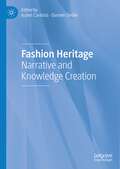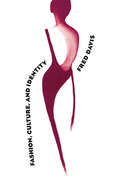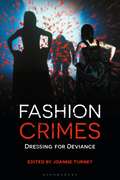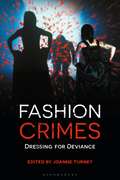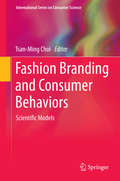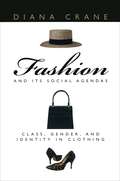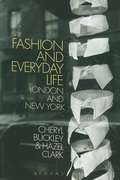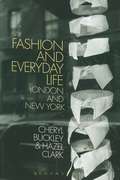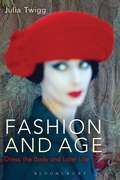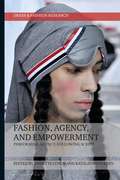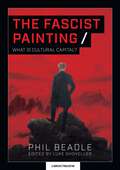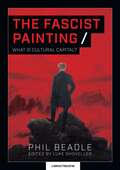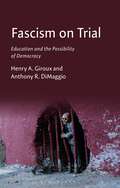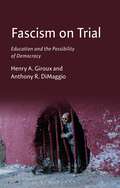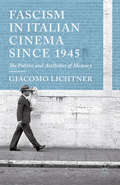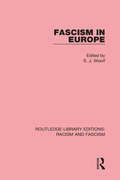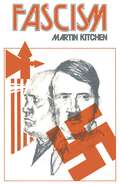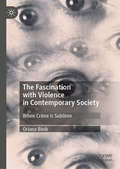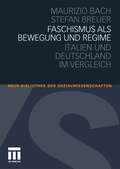- Table View
- List View
Fashion Heritage: Narrative and Knowledge Creation
by Isabel Cantista Damien DelilleThis edited volume explores how fashion brands deal with legacy by looking at the preservation of heritage and knowledge and how this builds a bridge to the future. Bringing together different reflections from the world of fashion, from gloves to virtual jewels, from luxury brand’s digital narratives to historical contexts, each chapter offers a narrative that is contemporary, yet linked to historical contexts. With these narratives, the book reveals how innovation builds on heritage, and how locally rooted traditional techniques connect to contemporary global production. It illustrates how ancestral processes renew, encouraging us to produce and consume more responsibly. Split into three parts, the book firstly covers narrative and knowledge in different contexts before delving in to narrative, brand building and creativity with case studies. The final section centres on digital narratives with new consumers. Ultimately, this book demonstrates that multidisciplinary knowledge of the past is essential to the understanding of the contemporary.
Fashion, Culture, and Identity
by Fred DavisWhat do our clothes say about who we are or who we think we are? How does the way we dress communicate messages about our identity? Is the desire to be "in fashion" universal, or is it unique to Western culture? How do fashions change? These are just a few of the intriguing questions Fred Davis sets out to answer in this provocative look at what we do with our clothes—and what they can do to us. Much of what we assume to be individual preference, Davis shows, really reflects deeper social and cultural forces. Ours is an ambivalent social world, characterized by tensions over gender roles, social status, and the expression of sexuality. Predicting what people will wear becomes a risky gamble when the link between private self and public persona can be so unstable.
Fashion Crimes: Dressing for Deviance
by Joanne TurneyFashion is widely recognised as a site for social acceptance and rejection, and as a signifier of personal identity. What happens when people stray from 'appropriate' dress codes or associate garments with 'respectability' or deviance? How does fashion relate to criminality? In this interdisciplinary volume, leading scholars propose new ways of seeing everyday dress and the body in public space. Garments and individual or group wearers are used as case studies to explore the codification of clothing as criminal – hoodies, trench-coats, Norwegian Lustkoffe sweaters, low-slung trousers and Hip Hop styling are all untangled as garments with criminal significance. The book questions the point at which morality as a form of social control meets criminality, and suggests ways to renegotiate established dress codes and terms such as 'suitability' and 'glamour' through the study of what people wear in response to notions of criminality.
Fashion Crimes: Dressing for Deviance
by Joanne TurneyFashion is widely recognised as a site for social acceptance and rejection, and as a signifier of personal identity. What happens when people stray from 'appropriate' dress codes or associate garments with 'respectability' or deviance? How does fashion relate to criminality? In this interdisciplinary volume, leading scholars propose new ways of seeing everyday dress and the body in public space. Garments and individual or group wearers are used as case studies to explore the codification of clothing as criminal – hoodies, trench-coats, Norwegian Lustkoffe sweaters, low-slung trousers and Hip Hop styling are all untangled as garments with criminal significance. The book questions the point at which morality as a form of social control meets criminality, and suggests ways to renegotiate established dress codes and terms such as 'suitability' and 'glamour' through the study of what people wear in response to notions of criminality.
Fashion Branding and Consumer Behaviors: Scientific Models (International Series on Consumer Science)
by Tsan-Ming ChoiFashion Branding and Consumer Behaviors presents eye-opening theory, literature review and original research on the mutual influence of branding strategies and consumer response. Contributors use multiple methods to analyze consumers' psychosocial needs and the extent that their fulfillment goes beyond the usefulness or value of the items they purchase as well as the fashion industry's means of communicating brand identity and enhancing brand loyalty. Along the way, these studies raise important questions about consumer behaviors, consumer welfare, environmental ethics and the future of consumer research. Included in the coverage: A symbolic interactionist perspective on fashion brand personality and advertisement response.Optimizing fashion branding strategies in a fluctuating market.An analysis of fashion brand extensions by artificial neural networks.Domestic or foreign luxury brands? A comparison of status- and non-status- seeking teenagers.The impact of consumers’ need for uniqueness on purchase perception.How brand awareness relates to market outcome, brand equity and the marketing mix. A breakthrough volume on the complexities of how and why we buy, Fashion Branding and Consumer Behaviors will captivate researchers and practitioners in the fields of consumer psychology, marketing and economics.
Fashion and Its Social Agendas: Class, Gender, and Identity in Clothing
by Diana CraneIt has long been said that clothes make the man (or woman), but is it still true today? If so, how has the information clothes convey changed over the years? Using a wide range of historical and contemporary materials, Diana Crane demonstrates how the social significance of clothing has been transformed. Crane compares nineteenth-century societies—France and the United States—where social class was the most salient aspect of social identity signified in clothing with late twentieth-century America, where lifestyle, gender, sexual orientation, age, and ethnicity are more meaningful to individuals in constructing their wardrobes. Today, clothes worn at work signify social class, but leisure clothes convey meanings ranging from trite to political. In today's multicode societies, clothes inhibit as well as facilitate communication between highly fragmented social groups. Crane extends her comparison by showing how nineteenth-century French designers created fashions that suited lifestyles of Paris elites but that were also widely adopted outside France. By contrast, today's designers operate in a global marketplace, shaped by television, film, and popular music. No longer confined to elites, trendsetters are drawn from many social groups, and most trends have short trajectories. To assess the impact of fashion on women, Crane uses voices of college-aged and middle-aged women who took part in focus groups. These discussions yield fascinating information about women's perceptions of female identity and sexuality in the fashion industry. An absorbing work, Fashion and Its Social Agendas stands out as a critical study of gender, fashion, and consumer culture. "Why do people dress the way they do? How does clothing contribute to a person's identity as a man or woman, as a white-collar professional or blue-collar worker, as a preppie, yuppie, or nerd? How is it that dress no longer denotes social class so much as lifestyle? . . . Intelligent and informative, [this] book proposes thoughtful answers to some of these questions."-Library Journal
Fashion and Its Social Agendas: Class, Gender, and Identity in Clothing
by Diana CraneIt has long been said that clothes make the man (or woman), but is it still true today? If so, how has the information clothes convey changed over the years? Using a wide range of historical and contemporary materials, Diana Crane demonstrates how the social significance of clothing has been transformed. Crane compares nineteenth-century societies—France and the United States—where social class was the most salient aspect of social identity signified in clothing with late twentieth-century America, where lifestyle, gender, sexual orientation, age, and ethnicity are more meaningful to individuals in constructing their wardrobes. Today, clothes worn at work signify social class, but leisure clothes convey meanings ranging from trite to political. In today's multicode societies, clothes inhibit as well as facilitate communication between highly fragmented social groups. Crane extends her comparison by showing how nineteenth-century French designers created fashions that suited lifestyles of Paris elites but that were also widely adopted outside France. By contrast, today's designers operate in a global marketplace, shaped by television, film, and popular music. No longer confined to elites, trendsetters are drawn from many social groups, and most trends have short trajectories. To assess the impact of fashion on women, Crane uses voices of college-aged and middle-aged women who took part in focus groups. These discussions yield fascinating information about women's perceptions of female identity and sexuality in the fashion industry. An absorbing work, Fashion and Its Social Agendas stands out as a critical study of gender, fashion, and consumer culture. "Why do people dress the way they do? How does clothing contribute to a person's identity as a man or woman, as a white-collar professional or blue-collar worker, as a preppie, yuppie, or nerd? How is it that dress no longer denotes social class so much as lifestyle? . . . Intelligent and informative, [this] book proposes thoughtful answers to some of these questions."-Library Journal
Fashion and Its Social Agendas: Class, Gender, and Identity in Clothing
by Diana CraneIt has long been said that clothes make the man (or woman), but is it still true today? If so, how has the information clothes convey changed over the years? Using a wide range of historical and contemporary materials, Diana Crane demonstrates how the social significance of clothing has been transformed. Crane compares nineteenth-century societies—France and the United States—where social class was the most salient aspect of social identity signified in clothing with late twentieth-century America, where lifestyle, gender, sexual orientation, age, and ethnicity are more meaningful to individuals in constructing their wardrobes. Today, clothes worn at work signify social class, but leisure clothes convey meanings ranging from trite to political. In today's multicode societies, clothes inhibit as well as facilitate communication between highly fragmented social groups. Crane extends her comparison by showing how nineteenth-century French designers created fashions that suited lifestyles of Paris elites but that were also widely adopted outside France. By contrast, today's designers operate in a global marketplace, shaped by television, film, and popular music. No longer confined to elites, trendsetters are drawn from many social groups, and most trends have short trajectories. To assess the impact of fashion on women, Crane uses voices of college-aged and middle-aged women who took part in focus groups. These discussions yield fascinating information about women's perceptions of female identity and sexuality in the fashion industry. An absorbing work, Fashion and Its Social Agendas stands out as a critical study of gender, fashion, and consumer culture. "Why do people dress the way they do? How does clothing contribute to a person's identity as a man or woman, as a white-collar professional or blue-collar worker, as a preppie, yuppie, or nerd? How is it that dress no longer denotes social class so much as lifestyle? . . . Intelligent and informative, [this] book proposes thoughtful answers to some of these questions."-Library Journal
Fashion and Its Social Agendas: Class, Gender, and Identity in Clothing
by Diana CraneIt has long been said that clothes make the man (or woman), but is it still true today? If so, how has the information clothes convey changed over the years? Using a wide range of historical and contemporary materials, Diana Crane demonstrates how the social significance of clothing has been transformed. Crane compares nineteenth-century societies—France and the United States—where social class was the most salient aspect of social identity signified in clothing with late twentieth-century America, where lifestyle, gender, sexual orientation, age, and ethnicity are more meaningful to individuals in constructing their wardrobes. Today, clothes worn at work signify social class, but leisure clothes convey meanings ranging from trite to political. In today's multicode societies, clothes inhibit as well as facilitate communication between highly fragmented social groups. Crane extends her comparison by showing how nineteenth-century French designers created fashions that suited lifestyles of Paris elites but that were also widely adopted outside France. By contrast, today's designers operate in a global marketplace, shaped by television, film, and popular music. No longer confined to elites, trendsetters are drawn from many social groups, and most trends have short trajectories. To assess the impact of fashion on women, Crane uses voices of college-aged and middle-aged women who took part in focus groups. These discussions yield fascinating information about women's perceptions of female identity and sexuality in the fashion industry. An absorbing work, Fashion and Its Social Agendas stands out as a critical study of gender, fashion, and consumer culture. "Why do people dress the way they do? How does clothing contribute to a person's identity as a man or woman, as a white-collar professional or blue-collar worker, as a preppie, yuppie, or nerd? How is it that dress no longer denotes social class so much as lifestyle? . . . Intelligent and informative, [this] book proposes thoughtful answers to some of these questions."-Library Journal
Fashion and Everyday Life: London and New York
by Cheryl Buckley Dr Hazel ClarkTaking cultural theorist Michel de Certeau's notion of 'the everyday' as a critical starting point, this book considers how fashion shapes and is shaped by everyday life. Looking historically for the imprint of fashion within everyday routines such as going to work or shopping, or in leisure activities like dancing, the book identifies the 'fashion system of the ordinary', in which clothing has a distinct role in the making of self and identity. Exploring the period from 1890 to 2010, the study is located in London and New York, cities that emerged as as socially, ethnically and culturally diverse, as well as increasingly fashionable. The book re-focuses fashion discourse away from well-trodden, power-laden dynamics, towards a re-evaluation of time, memory, and above all history, and their relationship to fashion and everyday life. The importance of place and space - and issues of gender, race and social class - provides the broader framework, revealing fashion as both routine and exceptional, and as an increasingly significant part of urban life. By focusing on key themes such as clothing the city, what is worn on the streets, the imagining and performing of multiple identities by dressing up and down, going out, and showing off, Fashion and Everyday Life makes a unique contribution to the literature of fashion studies, fashion history, cultural studies, and beyond.
Fashion and Everyday Life: London and New York
by Cheryl Buckley Hazel ClarkTaking cultural theorist Michel de Certeau's notion of 'the everyday' as a critical starting point, this book considers how fashion shapes and is shaped by everyday life. Looking historically for the imprint of fashion within everyday routines such as going to work or shopping, or in leisure activities like dancing, the book identifies the 'fashion system of the ordinary', in which clothing has a distinct role in the making of self and identity. Exploring the period from 1890 to 2010, the study is located in London and New York, cities that emerged as as socially, ethnically and culturally diverse, as well as increasingly fashionable. The book re-focuses fashion discourse away from well-trodden, power-laden dynamics, towards a re-evaluation of time, memory, and above all history, and their relationship to fashion and everyday life. The importance of place and space - and issues of gender, race and social class - provides the broader framework, revealing fashion as both routine and exceptional, and as an increasingly significant part of urban life. By focusing on key themes such as clothing the city, what is worn on the streets, the imagining and performing of multiple identities by dressing up and down, going out, and showing off, Fashion and Everyday Life makes a unique contribution to the literature of fashion studies, fashion history, cultural studies, and beyond.
Fashion and Age: Dress, the Body and Later Life
by Julia TwiggThroughout history certain forms and styles of dress have been deemed appropriate - or more significantly, inappropriate - for people as they age. Older women in particular have long been subject to social pressure to tone down, to adopt self-effacing, covered-up styles. But increasingly there are signs of change, as older women aspire to younger, more mainstream, styles, and retailers realize the potential of the 'grey market'. Fashion and Age is the first study to systematically explore the links between clothing and age, drawing on fashion theory and cultural gerontology to examine the changing ways in which age is imagined, experienced and understood in modern culture through the medium of dress. Clothes lie between the body and its social expression, and the book explores the significance of embodiment in dress and in the cultural constitution of age.Drawing on the views of older women, journalists and fashion editors, and clothing designers and retailers, it aims to widen the agenda of fashion studies to encompass the everyday dress of the majority, shifting the debate about age away from its current preoccupation with dependency, towards a fuller account of the lived experience of age. Fashion and Age will be of great interest to students of fashion, material culture, sociology, sociology of age, history of dress and to clothing designers.
Fashion and Age: Dress, the Body and Later Life
by Julia TwiggThroughout history certain forms and styles of dress have been deemed appropriate - or more significantly, inappropriate - for people as they age. Older women in particular have long been subject to social pressure to tone down, to adopt self-effacing, covered-up styles. But increasingly there are signs of change, as older women aspire to younger, more mainstream, styles, and retailers realize the potential of the 'grey market'. Fashion and Age is the first study to systematically explore the links between clothing and age, drawing on fashion theory and cultural gerontology to examine the changing ways in which age is imagined, experienced and understood in modern culture through the medium of dress. Clothes lie between the body and its social expression, and the book explores the significance of embodiment in dress and in the cultural constitution of age.Drawing on the views of older women, journalists and fashion editors, and clothing designers and retailers, it aims to widen the agenda of fashion studies to encompass the everyday dress of the majority, shifting the debate about age away from its current preoccupation with dependency, towards a fuller account of the lived experience of age. Fashion and Age will be of great interest to students of fashion, material culture, sociology, sociology of age, history of dress and to clothing designers.
Fashion, Agency, and Empowerment: Performing Agency, Following Script (Dress and Fashion Research)
by Annette Lynch Katalin MedvedevFashion has always been strongly linked with the politics of gender and equality. In this global and interdisciplinary collection, leading authors explore the relationships between the dressed body, fashion, sex, and power, with an emphasis on the role of dress in both reinforcing and challenging social norms.Covering a range of geographic and social contexts, the book explores the role of fashion in empowering both individuals and groups to create transformation and change. Taking us from the performance of black dandyism through stylized hats, to the use of challenging dance forms and male-inspired dress by female South African dancers to express independence and equality, to ways in which recent Bond Girls have challenged traditional gender binaries, the book provides a crucial entry point into discussions of fashion as an empowerment strategy.Fashion, Agency, and Empowerment encourages the reader to critically examine the cultural and social impact of sexual objectification, as well as to consider personal and shared narratives of self-objectification and repression. With chapters ranging from the iconic self-fashioning of Princess Diana to a discussion of sex, power, and cultural constructions of masculinity, Fashion, Agency, and Empowerment provides crucial insights into global fashion, political structures, and social life.
Fashion, Agency, and Empowerment: Performing Agency, Following Script (Dress and Fashion Research)
by Annette Lynch Professor Katalin MedvedevFashion has always been strongly linked with the politics of gender and equality. In this global and interdisciplinary collection, leading authors explore the relationships between the dressed body, fashion, sex, and power, with an emphasis on the role of dress in both reinforcing and challenging social norms.Covering a range of geographic and social contexts, the book explores the role of fashion in empowering both individuals and groups to create transformation and change. Taking us from the performance of black dandyism through stylized hats, to the use of challenging dance forms and male-inspired dress by female South African dancers to express independence and equality, to ways in which recent Bond Girls have challenged traditional gender binaries, the book provides a crucial entry point into discussions of fashion as an empowerment strategy.Fashion, Agency, and Empowerment encourages the reader to critically examine the cultural and social impact of sexual objectification, as well as to consider personal and shared narratives of self-objectification and repression. With chapters ranging from the iconic self-fashioning of Princess Diana to a discussion of sex, power, and cultural constructions of masculinity, Fashion, Agency, and Empowerment provides crucial insights into global fashion, political structures, and social life.
The Fascist Painting: What is Cultural Capital?
by Phil BeadleThe Fascist Painting is a serious, rich and deeply intelligent piece of work that will radically alter the way we view culture in schools and will be a key text for anyone designing a curriculum. The Ofsted Inspection Framework states that cultural capital is 'The essential knowledge that pupils need to be educated citizens' and that schools 'should be introducing [students] to the best that has been thought and said and helping to engender an appreciation of human creativity and achievement'. They are now considering, 'the extent to which schools are equipping pupils with the knowledge and cultural capital they need to succeed in life.' But what does this term mean? And how are schools to respond to this? In this densely argued and wide-ranging text, Phil Beadle answers those questions and many more by using the work of Pierre Bourdieu to prompt a discussion of how we improve the provision of cultural capital in our schools. Where does the best that has been thought and said come from? Why is the government importing the unexamined language of the private school into the state sector? What is the real purpose behind character education? Does sport, as is reputed, teach resilience, and why would anyone think it was appropriate to teach children a quality they already have? Is cultural capital just ruling class culture? Chiefly, does using a term originated by a French intellectual and radical sociologist to instate the culture of the rich as being superior prove anything other more than a complete absence of thought, or have they accidentally given us a radical tool to change education for the better?
The Fascist Painting: What is Cultural Capital?
by Phil BeadleThe Fascist Painting is a serious, rich and deeply intelligent piece of work that will radically alter the way we view culture in schools and will be a key text for anyone designing a curriculum. The Ofsted Inspection Framework states that cultural capital is 'The essential knowledge that pupils need to be educated citizens' and that schools 'should be introducing [students] to the best that has been thought and said and helping to engender an appreciation of human creativity and achievement'. They are now considering, 'the extent to which schools are equipping pupils with the knowledge and cultural capital they need to succeed in life.' But what does this term mean? And how are schools to respond to this? In this densely argued and wide-ranging text, Phil Beadle answers those questions and many more by using the work of Pierre Bourdieu to prompt a discussion of how we improve the provision of cultural capital in our schools. Where does the best that has been thought and said come from? Why is the government importing the unexamined language of the private school into the state sector? What is the real purpose behind character education? Does sport, as is reputed, teach resilience, and why would anyone think it was appropriate to teach children a quality they already have? Is cultural capital just ruling class culture? Chiefly, does using a term originated by a French intellectual and radical sociologist to instate the culture of the rich as being superior prove anything other more than a complete absence of thought, or have they accidentally given us a radical tool to change education for the better?
Fascism on Trial: Education and the Possibility of Democracy
by Henry A. Giroux Anthony R. DiMaggioThis book interrogates rising fascism in America. It spotlights the major facets of fascism that increasingly characterize contemporary US politics, in relation to political authoritarianism, the rise of anti-intellectualism, the mainstreaming of conspiracy theories, the glorification of political street violence and state violence, rising white supremacy, and the militarization of US political discourse. Alongside this, Giroux and DiMaggio show how the assault on critical education and pedagogy is central to the fascist program. They stress the importance of reprioritizing education as a public good to combating fascist politics and ideology and draw links between fascism and the banning of books in schools, whitewashing history, and punishing policies aimed at Black, Brown, and transgender youth. They challenge the commonly embraced notion that Trumpism is primarily a function of economic insecurity within his support base, documenting how support for the former president primarily centered on reactionary socio-cultural values and white supremacy. They also show how white supremacist values are central to the Trump base defending the January 6th insurrection, despite academics, journalists, and political officials in both major parties ignoring the threat of rising white nationalism.
Fascism on Trial: Education and the Possibility of Democracy
by Henry A. Giroux Anthony R. DiMaggioThis book interrogates rising fascism in America. It spotlights the major facets of fascism that increasingly characterize contemporary US politics, in relation to political authoritarianism, the rise of anti-intellectualism, the mainstreaming of conspiracy theories, the glorification of political street violence and state violence, rising white supremacy, and the militarization of US political discourse. Alongside this, Giroux and DiMaggio show how the assault on critical education and pedagogy is central to the fascist program. They stress the importance of reprioritizing education as a public good to combating fascist politics and ideology and draw links between fascism and the banning of books in schools, whitewashing history, and punishing policies aimed at Black, Brown, and transgender youth. They challenge the commonly embraced notion that Trumpism is primarily a function of economic insecurity within his support base, documenting how support for the former president primarily centered on reactionary socio-cultural values and white supremacy. They also show how white supremacist values are central to the Trump base defending the January 6th insurrection, despite academics, journalists, and political officials in both major parties ignoring the threat of rising white nationalism.
Fascism in Italian Cinema since 1945: The Politics and Aesthetics of Memory
by G. LichtnerFrom neorealism's resolve to Berlusconian revisionist melodramas, this book examines cinema's role in constructing memories of Fascist Italy. Italian cinema has both reflected and shaped popular perceptions of Fascism, reinforcing or challenging stereotypes, remembering selectively and silently forgetting the most shameful pages of Italy's history.
Fascism in Europe (Routledge Library Editions: Racism and Fascism)
by S. J. WoolfWhat was fascism, why did it gain support between the wars, and could it happen again? This collection of essays, published in 1981, by leading authorities on the subject, offers a comprehensive study of European fascism, with a detailed analysis of its roots, its extraordinary strength between the two world wars, and its prospects in modern Europe. The essays discuss the economic, political and social conditions out of which individual fascist movements arose, the crucial problem of why a few fascist parties succeeded but most failed. The essays on Italy, Germany and Spain examine the continuities and contradictions between the fascist movements in opposition and the fascist regimes in power. The introductory and conclusive essays are concerned with the overall problem of the historical nature of the fascist phenomenon, but all the papers address themselves directly to this theme, testing the generalizations made by social scientists against the historical experiences of individual countries. Besides Italy and Germany, which harboured the major fascist movements, the countries discussed range from those with traditional parliamentary democracies – such as England, France, Belgium and Norway – to the new states which emerged from the collapse of the central European empires, such as Austria, Hungary, Romania and Poland. Originally published in 1968 under the title European Fascism, this survey acquired a worldwide reputation for its excellent and wide-ranging account of the history, role and functions of fascism in Europe. The present edition contains six new or wholly re-written essays and three substantially revised ones.
Fascism in Europe (Routledge Library Editions: Racism and Fascism)
by S. J. WoolfWhat was fascism, why did it gain support between the wars, and could it happen again? This collection of essays, published in 1981, by leading authorities on the subject, offers a comprehensive study of European fascism, with a detailed analysis of its roots, its extraordinary strength between the two world wars, and its prospects in modern Europe. The essays discuss the economic, political and social conditions out of which individual fascist movements arose, the crucial problem of why a few fascist parties succeeded but most failed. The essays on Italy, Germany and Spain examine the continuities and contradictions between the fascist movements in opposition and the fascist regimes in power. The introductory and conclusive essays are concerned with the overall problem of the historical nature of the fascist phenomenon, but all the papers address themselves directly to this theme, testing the generalizations made by social scientists against the historical experiences of individual countries. Besides Italy and Germany, which harboured the major fascist movements, the countries discussed range from those with traditional parliamentary democracies – such as England, France, Belgium and Norway – to the new states which emerged from the collapse of the central European empires, such as Austria, Hungary, Romania and Poland. Originally published in 1968 under the title European Fascism, this survey acquired a worldwide reputation for its excellent and wide-ranging account of the history, role and functions of fascism in Europe. The present edition contains six new or wholly re-written essays and three substantially revised ones.
Fascism
by Martin KitchenThis concise and lucidly written book is designed as an introduction to theories of fascism. Martin Kitchen, a distinguished scholar of German history and politics, assesses the rival claims of the main theories. These include those of the Communist International (which had such a significant political impact at the time), the more important of the psychological explanations of fascism, the theories of totalitarianism which dominated western political science in the 1950s and 1960s, the attempt by Ernst Nolte to find a way out of the impasse in which the theory of totalitarianism found itself, theories of fascism as an independent movement of the disgruntled middle classes and, lastly, fascism as a new form of Bonapartism. There is also discussion of the important question of the relationships between fascism and industry, using the examples of Italy and Germany.The various theories are discussed under two headings - 'heteronomic' and 'autonomic', the former asserting that fascism is directly produced and determined by capitalism, and the latter arguing that fascism is an independent force. In his final chapter, Martin Kitchen shows how neither sort of theory alone is satisfactory, and that both must play a part in producing a helpful theory. That this can be done is shown in the conclusion where a tentative answer is given to the question 'What is Fascism?'
The Fascination with Violence in Contemporary Society: When Crime is Sublime (Palgrave Studies In Crime, Media And Culture Ser.)
by Oriana BinikThis book directly explores the question of why contemporary society is so fascinated with violence and crime. The Fascination with Violence in Contemporary Society posits that the phenomenon is, in part, because we have all become consumers of the sublime: an intense and strongly ambiguous emotion which is increasingly commodified. Through the experience of violence and the sense of disorientation that accompanies it, we obsessively seek out moments of intensified existence. Equally, crime continues to speak to the depths of the collective unconscious, questioning us about our transience and the model of society we wish to live in. Binik proposes that this is why the reaction to violence has become a tool with which to express and take ownership of a desire for social cohesion. This book uses interviews with viewers, dark tourists, collectors and others to further interrogate this social trend. Many of these are participants in the four key case studies explored within the study: emotional pathways while watching a true-crime TV series, the trend of dark tourism, murderabilia collecting and the fanaticism of (and for) Anders Breivik. This book seeks to answer one of the most pressing cultural trends of the modern age and fill in a gap in the criminological literature on the subject.
Faschismus als Bewegung und Regime: Italien und Deutschland im Vergleich (Neue Bibliothek der Sozialwissenschaften)
by Maurizio Bach Stefan BreuerFaschismus ist ein generelles Phänomen, das jedoch nur in Italien und Deutschland zur vollen Entfaltung kam. Das wird in diesem Band sowohl in typologischer als auch in empirisch-vergleichender Perspektive dargelegt. Gezeigt werden soll, welchen Beitrag die Herrschaftssoziologie Max Webers zur Deutung und Erklärung des Faschismus leisten kann. Schwerpunkte liegen auf dem Verhältnis von Vergemeinschaftung und Vergesellschaftung in der Bewegungsphase sowie der Veralltäglichung des Charisma in der Regimephase, die in Italien zu einer Stabilisierung bürokratisch-zentralistischer Strukturen führte, in Deutschland dagegen eine De-Institutionalisierung der staatlichen Ordnung bewirkte.
